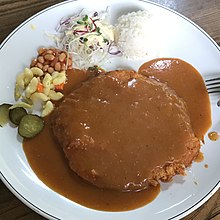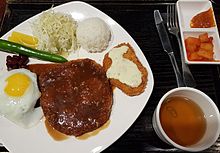| This article's lead section may be too short to adequately summarize the key points. Please consider expanding the lead to provide an accessible overview of all important aspects of the article. (February 2019) |

Dongaseu (Korean: 돈가스, IPA: ) is a Koreanized version of Japanese tonkatsu. It consists of a breaded, deep-fried pork cutlet. Typically it is served with sauce glazed over the top, with white rice and a vegetable based banchan side dish.
History
The dish was introduced to Korea around 1930s during the period of Japanese rule, but the thick, Japanese-style tonkatsu failed to gain popularity. Don-gaseu became popular in the 1960s, with the spread of gyeong-yangsik—light western food—restaurants. The dish, although called by the Japanese-derived name don-gaseu, followed Western pork cutlet recipes such as those of the Austrian Schnitzel—thinned by pounding before being breaded and deep-fried. It was not sliced, and served with bread. Western-style appetizer soup was served before the dish. Don-gaseu developed into two distinct varieties. In 1977, gyeong-yangsik-style don-gaseu with thin meat became a popular menu in gisa-sikdang—drivers' restaurant, similar to transport café, for taxi drivers—with the addition of chili peppers and kimchi as an accompaniment. As gyeong-yangsik restaurants nearly disappeared, this style of don-gaseu is now commonly served in drivers' restaurants and bunsik-jip (snack restaurants). A second style of don-gaseu, with thicker meat and served sliced following the Japanese method, was made popular in 1983 by a restaurant called Myeongdong Dongaseu. This style of don-gaseu is now commonly served in authentic Japanese restaurants.
Preparation and serving

Korean don-gaseu is different from Japanese tonkatsu in that it is thinner and often served unsliced, thus eaten with a knife and fork, not chopsticks, and is served with demi-glace on top of the fried meat (or in case of fish cutlet, tartar sauce on the fried fish). Common accompaniments include shredded cabbage sprinkled with ketchup-mayonnaise mixture, baked beans, macaroni salad, sweet corn, and danmuji (yellow pickled radish). Green chili peppers and doenjang (soybean paste) or ssamjang (wrap sauce) for dipping the chili peppers, baechu-kimchi (cabbage kimchi) or kkakdugi (radish kimchi), and rice with Korean or Japanese style soup can be served with the don-gaseu plate. Alternatively, bread can replace rice, in which case Western-style soup is served before the main plate as an appetizer.
Variations

- Saengseon-gaseu (생선가스), a fish cutlet similar to don-gaseu, is served with tartar sauce, instead of demi-glace.
See also
- List of pork dishes
- Tonkatsu, a similar Japanese dish
References
- ^ 박, 미향 (21 September 2016). "장사꾼의 끈기, '돈가스의 역사'를 쓰다". The Hankyoreh (in Korean). Retrieved 21 June 2017.
- ^ 김, 철현 (3 October 2016). "한국식 돈까스는 왜 고추와 함께 먹을까?". The Asia Economy Daily (in Korean). Retrieved 21 June 2017.
- ^ 박, 정배 (5 October 2015). "서양, 일본을 거친 오묘한 변주곡". Weekly Dong-A (in Korean). No. 1007. p. 76. Retrieved 21 June 2017.